Part 2
Š-ŔÉŚ™ Financial Engineering
Supereconomics Book 2
THE HOW
Š-ŔÉŚ™ Financial Engineering (Video 34b)
Next, we see four illustrations of Š-ŔÉŚ™ inspired by Kate Raworth and Donella Meadows.
The power comes from the monopoly effect É, where if É = 100% the network of businesses is exclusively buying and selling within the network. And we can use combinations of É and Śpin to increase the cash flow.
History 3
History 2
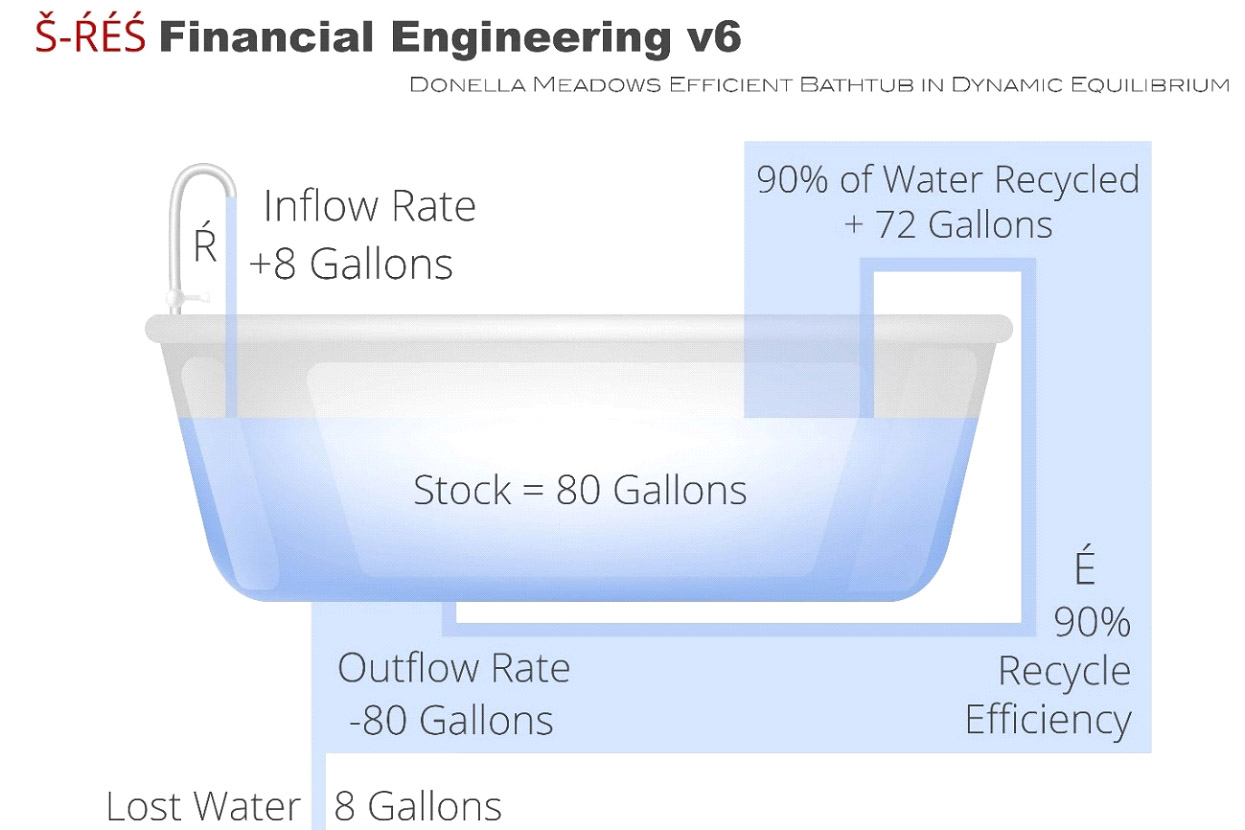
- Ŕ is for Ŕevenue – How much new money is added to the system. It is a combination of investment, sales, exports, and aid that the Network City receives within a year.
- É is for recycle-Éfficiency – In this case, É = 90%, so 90% of the money that would have escaped down the drain is captured, conserved, and returned to the network.
- Ś is for Śpin – The number of times the system completely recycles. In the illustration above, we see this only once, so Śpin is one – written as Ś1.
- Š is for Šavings – The amount of cash flow left after the last Śpin in a year, which carries over as revenue that we call Šavings the following year.
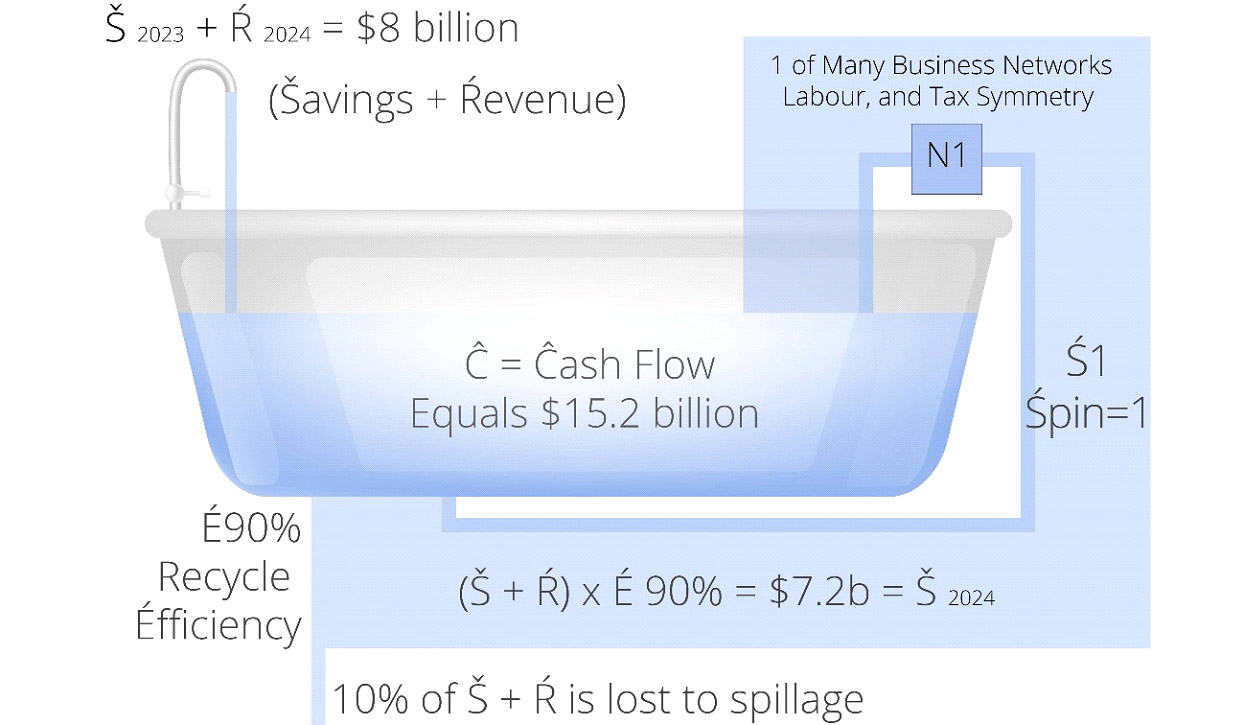
The Ś in Š-ŔÉŚ™ Financial Engineering
Š is for Śpin The number of times the system completely recycles. In the last illustration, we see this only once, so Śpin is one (Ś1). In the illustrations below, we see Śpin 2 and Śpin 3.
The trick is to apply Śpin, so the network spends all its cash flow more than once a year.
Staring with $8 billion in Š+Ŕ (savings and revenue) and a recycle-Éfficiency of 90% each company spends 90% its cash flow on labour, parts, goods and services from other companies in the network, evenly spread so, at the end, all the companies in the network have received roughly 90% of the cash flow they started with.
Critically this happens in the first seven months (Jan to July). Then in August 2025 we apply Śpin and spend the recycled $7.2 billion. Thus, the cash flow for the network in 2025 increased from $8 billion to $15.2 billion USD.

lastly comes the Šavings, which sees $6.48 billion left in the network (in cash USD) carried over to 2026 and the next graphic.
In 2026 by shortening the time before the first Śpin from seven months to five and shortening the time of the second Śpin to four months, then adding a 3rd Śpin from October to December. By the end of the year, we increase cash flow in 2026 to $21.68 billion. Plus $5.832 in Šavings carries to 2027

Below we start looking at the S-World Spreadsheet: Supereconomics–4-72
Moving to History 3 figures, these cash flow figures are critical, and are found on the spreadsheet tab; H3) ŠÉŚ-v5 | S-World History 3b – This is the most important tab within the spreadsheet. The best way to look at them is via the video.
History 3 www.angeltheory.org/video/34b
Below, we follow the same pattern as seen in the bathtub illustrations and jump to the cash flow that amasses in the Malawi Network HISTORY 3 Simulation. Staring with $5.7 billion in 2024 and ending with the equivalent of one percent of global GDP, and the building of over 10 million quality homes by 2080. (Tab: H3) ŠÉŚ-v5 Cash Flow & Housing)
| Š-ŔÉŚ™ | |||||
|---|---|---|---|---|---|
| History 3b | |||||
| Cash Flow | |||||
| 2024 | $ 5,685,975,000 | 2043 | $ 550,714,971,856 | 2062 | $ 3,376,984,627,114 |
| 2025 | $ 14,894,843,486 | 2044 | $ 589,005,884,788 | 2063 | $ 3,552,322,716,992 |
| 2026 | $ 26,848,936,252 | 2045 | $ 626,776,157,817 | 2064 | $ 3,735,466,074,599 |
| 2027 | $ 40,971,349,217 | 2046 | $ 664,266,326,401 | 2065 | $ 3,926,947,476,099 |
| 2028 | $ 53,185,830,818 | 2047 | $ 701,751,588,557 | 2066 | $ 4,127,305,216,341 |
| 2029 | $ 63,141,839,466 | 2048 | $ 867,395,313,639 | 2067 | $ 4,337,086,514,746 |
| 2030 | $ 71,509,098,453 | 2049 | $ 1,075,319,548,307 | 2068 | $ 4,556,850,627,653 |
| 2031 | $ 79,448,245,354 | 2050 | $ 1,283,942,425,681 | 2069 | $ 4,787,171,721,158 |
| 2032 | $ 106,194,771,025 | 2051 | $ 1,492,617,377,974 | 2070 | $ 5,028,641,551,041 |
| 2033 | $ 142,028,749,241 | 2052 | $ 1,700,924,978,432 | 2071 | $ 5,281,871,990,009 |
| 2034 | $ 180,559,704,269 | 2053 | $ 1,908,662,235,155 | 2072 | $ 5,547,497,437,108 |
| 2035 | $ 221,041,648,096 | 2054 | $ 2,115,827,746,778 | 2073 | $ 5,826,177,139,597 |
| 2036 | $ 262,772,540,960 | 2055 | $ 2,322,603,780,468 | 2074 | $ 6,118,597,453,737 |
| 2037 | $ 305,124,961,846 | 2056 | $ 2,458,677,324,414 | 2075 | $ 6,425,474,067,699 |
| 2038 | $ 347,569,259,536 | 2057 | $ 2,598,598,977,445 | 2076 | $ 6,747,554,207,063 |
| 2039 | $ 389,688,563,209 | 2058 | $ 2,742,999,154,713 | 2077 | $ 7,085,618,841,083 |
| 2040 | $ 431,185,712,853 | 2059 | $ 2,892,474,879,905 | 2078 | $ 7,440,484,905,993 |
| 2041 | $ 471,882,760,113 | 2060 | $ 3,047,597,735,540 | 2079 | $ 7,813,007,560,030 |
| 2042 | $ 511,714,147,224 | 2061 | $ 3,208,920,785,137 | 2080 | $ 8,204,082,483,521 |
| % of Global GDP: | 2080 | 1.07% | |||
| Social houses built: | Villas: | 10,118,720 | |||
From this base, the POP Law (chapter 18) increases the number of companies from 2048 in 2024 to 327,680 in 2080. We don’t see it, but on average, each company has 32 personnel for a total of 65,546 personnel earning $21,690 in 2024 who pay 25% of their remuneration towards Paid2Learn welfare, where 262,233 people benefit from $1,356 each year, which does not sound like much. But the World Bank says that, in 2018, the average Malawian made only $250 a year; thus, $1,356 is substantial.
Š-ŔÉŚ™ Financial Engineering – History 3; Cash Flow, companies, labour and trainees.
| Š-ŔÉŚ™ | Financial Engineering | ||||||
|---|---|---|---|---|---|---|---|
| Network Credits Ťender |
Network Credits Ťender |
Network Credits Ťender |
Adjusted for Growth |
Adjusted for Growth |
Div. By |
Adjusted for Growth |
|
| Cash Flow | Number of Companies |
# of Spartan Contract Labour |
Spartan Labour Basic + Bonus1 |
# of Paid2Learn Trainees |
Trainees Per 1 Labour |
Paid2Learn Trainees Basic + Bonus1 |
|
| 2024 | $ 5,685,975,000 | 2,048 | 65,536 | $ 21,690 | 262,144 | 4 | $ 1,356 |
| 2025 | $ 14,894,843,486 | 5,120 | 163,840 | $ 22,173 | 573,440 | 3.5 | $ 1,584 |
| 2028 | $ 53,185,830,818 | 15,565 | 498,074 | $ 24,185 | 1,494,221 | 3 | $ 2,015 |
| 2032 | $ 106,194,771,025 | 24,576 | 786,432 | $ 27,707 | 2,359,296 | 3 | $ 2,309 |
| 2040 | $ 431,185,712,853 | 94,208 | 3,014,656 | $ 24,087 | 7,536,640 | 2.5 | $ 2,409 |
| 2048 | $ 867,395,313,639 | 131,072 | 4,194,304 | $ 27,207 | 10,485,760 | 2.5 | $ 2,721 |
| 2050 | $ 1,283,942,425,681 | 163,840 | 5,242,880 | $ 32,218 | 110,485,760 | 2 | $4,027 |
| 2060 | $ 2,892,474,879,905 | 245,760 | 7,864,320 | $ 37,800 | 15,728,640 | 2 | $ 4,725 |
| 2070 | $ 5,028,641,551,041 | 294,912 | 9,437,184 | $ 42,781 | 16,515,072 | 1.75 | $ 6,112 |
| 2080 | $ 8,204,082,483,521 | 327,680 | 10,485,760 | $ 49,072 | 15,728,640 | 1.5 | $ 8,179 |
At the end of the simulation, by the year 2080 (Angel City 5), we see 10,485,760 Spartan Contract personnel earning $49,072 per year (in today’s money), and 15,728,640 people on Paid2Lean trainee contracts receiving $8,179.
Malawi currently has a population of 18.62 million, but according to the Bill and Melinda Gates Foundation, this may double by the mid-century. And if Malawi becomes the economic beacon of light described in this book, it could double again from economic immigration. In which case, we will need to work closer to the more powerful History 2. Which (as-if by magic) tackles 15 years of recession and depressions and increase its cash flow every year, reaching 1% of global GDP by 2050.
In chapter 18 about POP, the section titled; ‘The Theoretical Minimum’ sees this system scaled to the world, and it was found to create enough jobs and educational places for about 15 billion people by 2080. With this said, one of the projects key goals is to see populations grow as little as possible. The theoretical minimum is purely hypothetical; can one create the theoretical minimum of jobs, welfare and education positions necessary for the end of poverty by 2080? To which in this case, the answer is yes.
(Note this point is in part inspired by Sam Altman)
History 3 www.angeltheory.org/video/34b
History 3 www.angeltheory.org/video/34
History 2 www.angeltheory.org/video/25
Supereconomics
Special Projects Allocations (3 & 4 of 4)
| Special Projects SET 3 of 4. | |||||
|---|---|---|---|---|---|
| SP | Reason Why | Type | # | Allocation | |
| 33 | Growth Theory versus Climate Change | Goal | 8 | $ | 379,452,000,000 |
| 34 | Net-Zero Industry | Companies | 8 | $ | 379,452,000,000 |
| 35 | Scarce Resources | Variable of Law | 1 | $ | 47,431,500,000 |
| 36 | Biodegradable Packaging and Plastics | Companies | 3 | $ | 142,294,500,000 |
| 37 | Recycling | Companies | 3 | $ | 142,294,500,000 |
| 38 | Waste Management | Companies | 6 | $ | 284,589,000,000 |
| 39 | Infrastructure | Companies | 16 | $ | 758,904,000,000 |
| 40 | Solar Arrays | S-World Power | Companies | 8 | $ | 379,452,000,000 |
| 41 | Internet | Companies | 8 | $ | 379,452,000,000 |
| 42 | S-World AE™ – Aid Efficiency | Software / R&D | 1 | $ | 47,431,500,000 |
| 43 | Welfare for the Villages (Paid2Learn 2) | Companies | 8 | $ | 379,452,000,000 |
| 44 | S-World Food | Companies | 8 | $ | 379,452,000,000 |
| 45 | S-World Air | Companies | 4 | $ | 189,726,000,000 |
| 46 | S-World Water | Companies | 8 | $ | 379,452,000,000 |
| 47 | Limiting Antibiotics and Pesticides? | Companies | 2 | $ | 94,863,000,000 |
| 48 | Is it Safe? | Observation | 4 | $ | 189,726,000,000 |
| Special Projects SET 4 of 4. | |||||
|---|---|---|---|---|---|
| SP | Reason Why | Type | # | Allocation | |
| 49 | Fort Malawi Garrison (Against Poachers) | Companies | 2 | $ | 94,863,000,000 |
| 50 | The Rule of Law and Institutions | Organization | 2 | $ | 94,863,000,000 |
| 51 | Female, Racial, LGBT, and other Equalities | Ideal | 2 | $ | 94,863,000,000 |
| 52 | Youth Projects | Companies | 4 | $ | 189,726,000,000 |
| 53 | Football & Sports Leagues (Paid 2 Learn 3) | Companies | 6 | $ | 284,589,000,000 |
| 54 | Malawi – 2034 FIFA World Cup Bid | Companies | 4 | $ | 189,726,000,000 |
| 55 | The Arts – Music, Stage, Art, Craft et al. | Companies | 4 | $ | 189,726,000,000 |
| 56 | Social Maternalism | Companies | 1 | $ | 47,431,500,000 |
| 57 | Ecole Maternelle (Kindergartens) | Companies | 1 | $ | 47,431,500,000 |
| 58 | Mental Health & Addiction | Companies | 2 | $ | 94,863,000,000 |
| 59 | Immigration | Organization | 1 | $ | 47,431,500,000 |
| 60 | S-World South Africa | New Network | 1 | $ | 47,431,500,000 |
| 61 | An Amazon™ Grand Network in Brazil? | New Network | 1 | $ | 47,431,500,000 |
| 62 | Angel Theory | Idea | 1 | $ | 47,431,500,000 |
| 63 | POP (Financial Gravity & Equality) | Law & M-System | 1 | $ | 47,431,500,000 |
| 64 | M-Systems (The Theory of Everything) | M-Systems | 1 | $ | 47,431,500,000 |
| Total Special Project Spending | 100% | 256 | $ | 12,142,464,000,000 | |
| Spent on Ecological Projects | 27.0% | 69 | $ | 3,272,773,500,000 | |
| Spent on Education – Paid 2 Learn et al. | 40.2% | 103 | $ | 4,885,444,500,000 | |
Š-ŔÉŚ™Financial Engineering
Monopoly Power in the Quantum Age
Creating Net-Zero Cities and wealth in locations of Extreme Poverty
Since 2011 when this project started, the systems and software have been entangled with city-sized property developments. In September 2011 the first ‘Grand Network’ was envisioned in Laconia, Southern Greece and labelled ‘New Sparta City of Science’ including the rule that it must make more O2 than CO2, and so it is now referred to as ‘New Sparta City of Science.’
See: www.S-World.biz/New-Sparta-2011
In the summer of 2011, the purpose of the network was defined by a single quote by Isaac Asimov
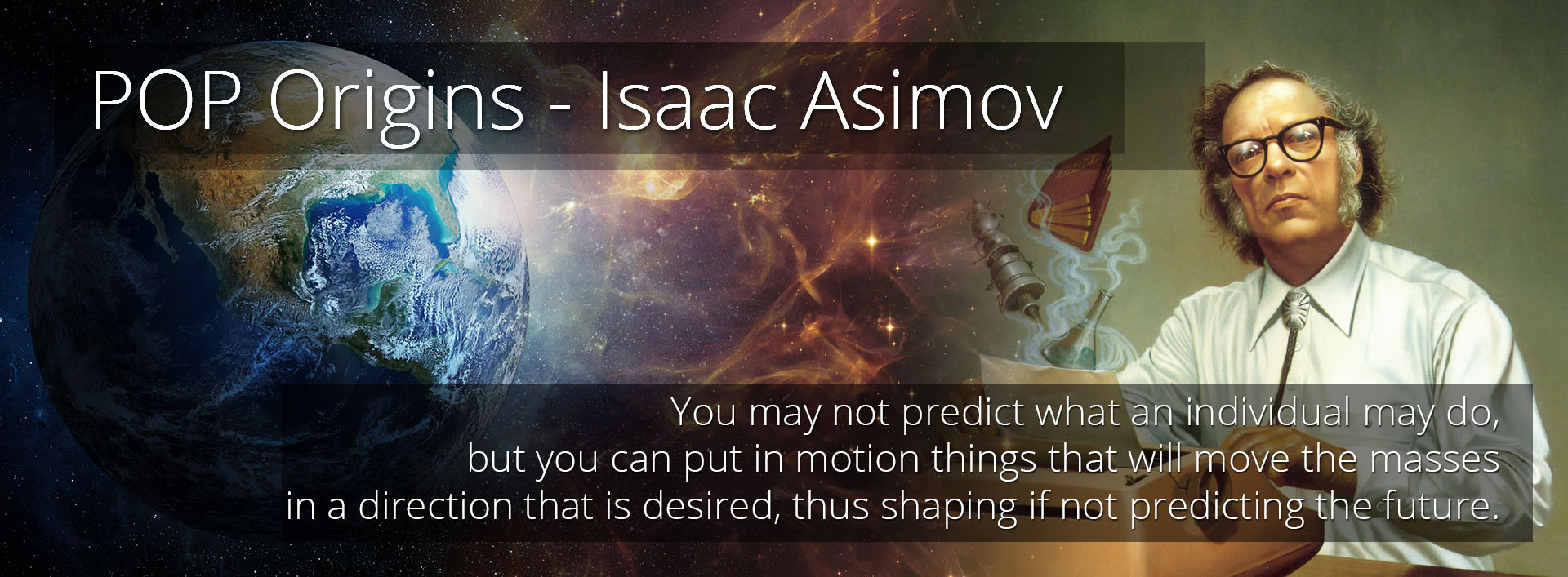
“You may not predict what an individual may do, but you can put in motion things that will move the masses in a direction that is desired, thus shaping if not predicting the future.”
We can now consider the 64 special projects as part of this process, by first looking at 2080 and working out what we want, as a set of special projects and economics, then in our time execute the S-World hypothesis and as they say; ‘the rest is history.’ (well 87 quintillion histories, but we must start somewhere.)
Another essential step in this plan are the Grand Śpin Networks, and I was, of course, overjoyed when one of the world-leading ‘massive city planners’ Paul Romer won the 2018 Nobel prize in economics. If we can add Romer and the Marron Institutes knowledge to aid this project (or vice versa), it can only come back stronger.
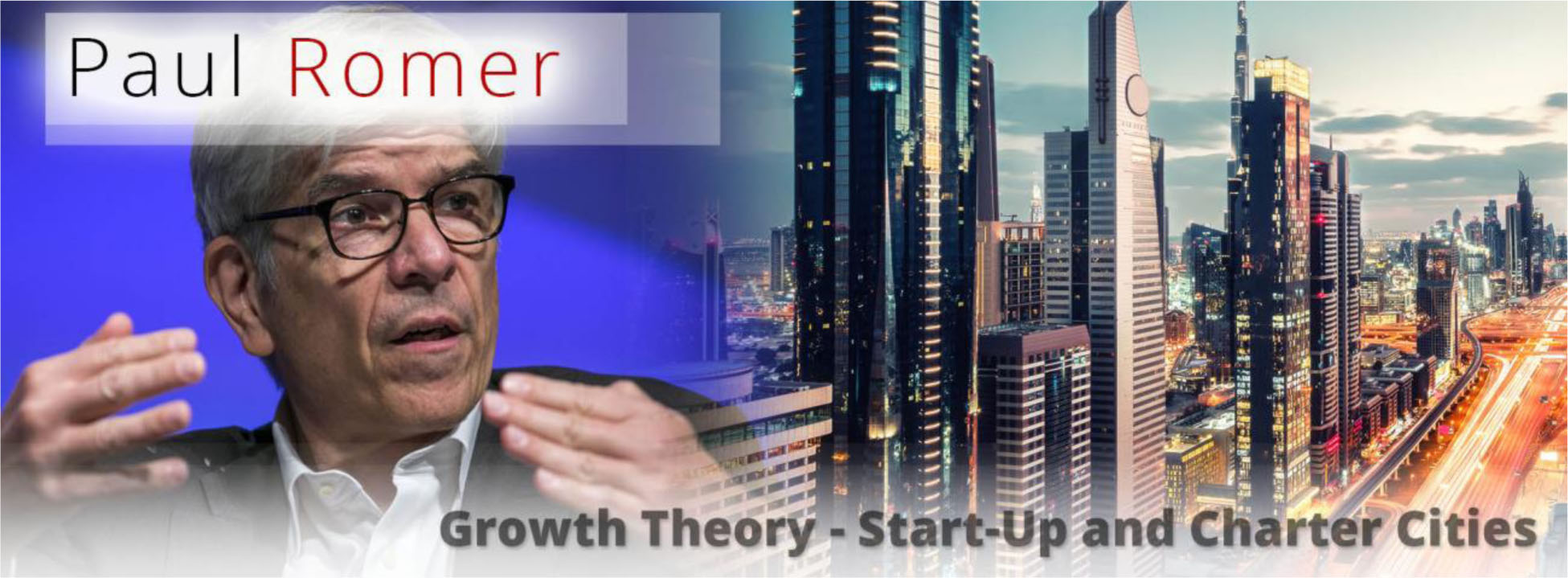
Poor Economics
A pivotal moment in S-World was found in listening to the audiobook ‘Poor Economics,’ by Esther Duflo and Abhijit V. Banerjee, and the section on charter cities, an idea by Paul Romer.
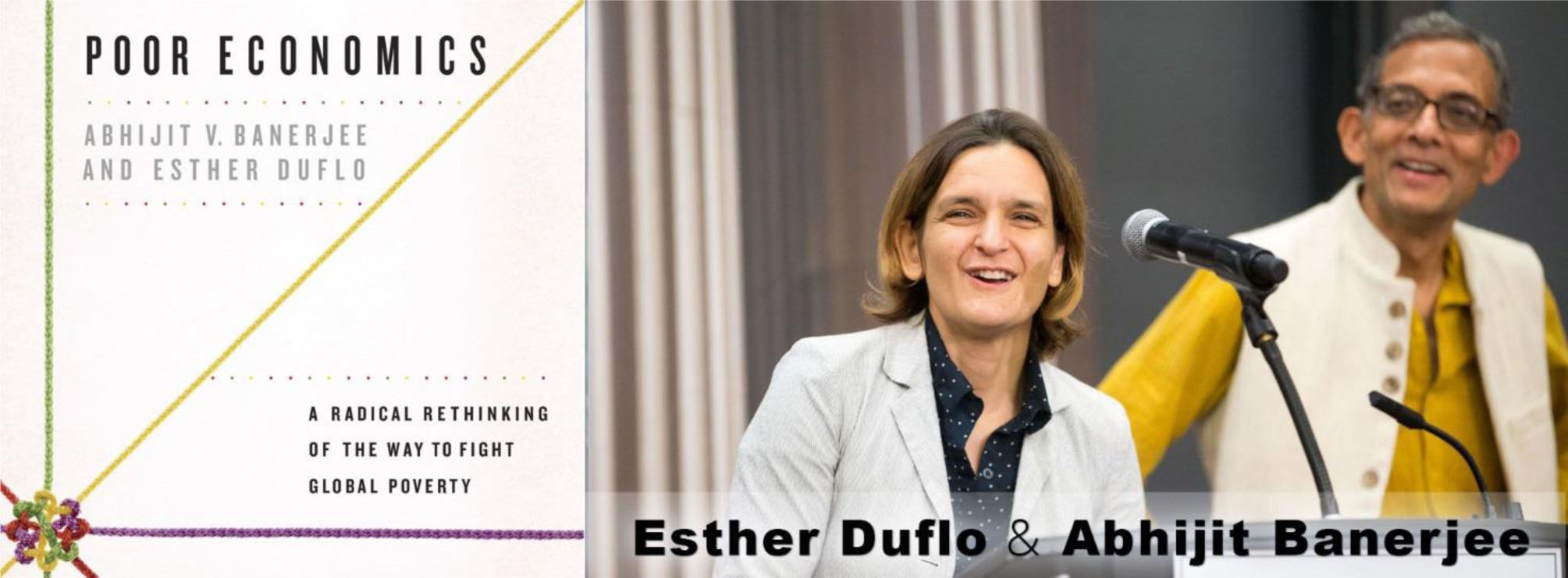
On reading this, I believed that if I could only get to Paul Romer, he would see merit in the marketing and economic systems in the network.
The extract from Poor Economics follows:
One possible way to break the vicious cycle of bad institutions is to import change from the outside. Paul Romer, known for his pioneering work on economic growth a couple of decades ago, came up with what seems like a brilliant solution: If you cannot run your country, subcontract it to someone who can. Still, running an entire country may be difficult. So, he proposes starting with cities, small enough to be manageable but large enough to make a difference. Inspired by the example of Hong Kong, developed with great success by the British and then handed back to China, he developed the concept of “charter cities.”
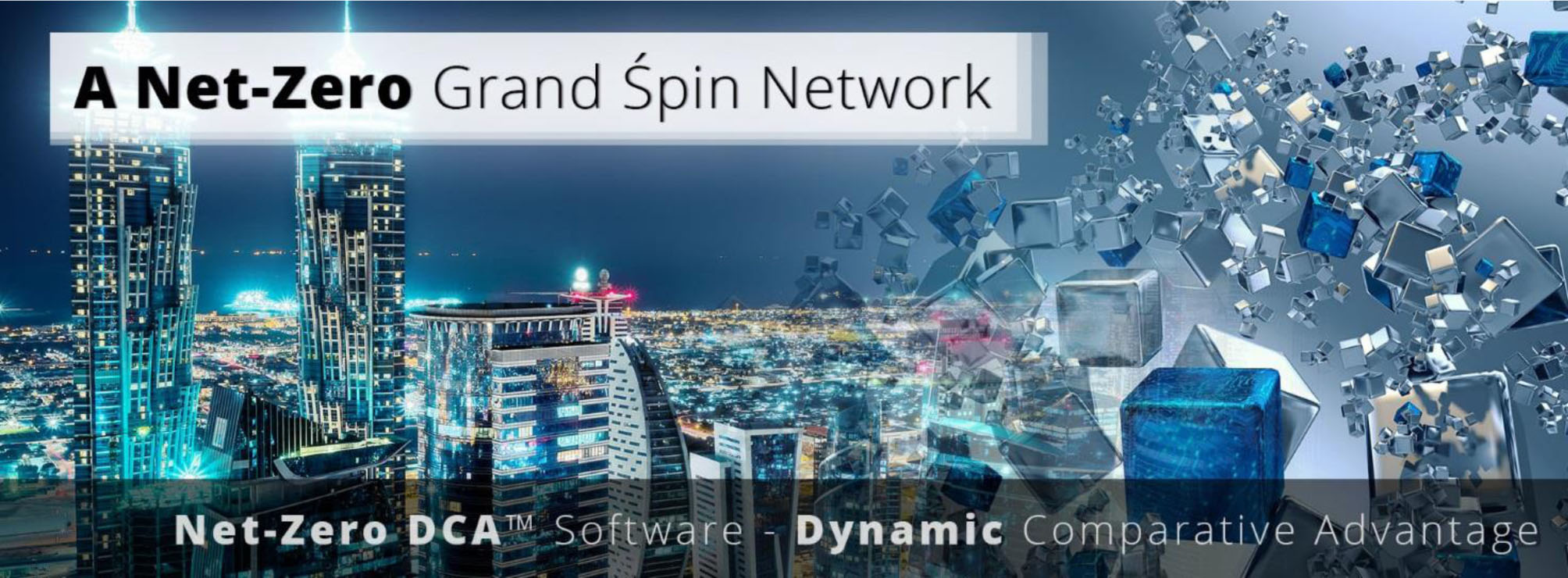
Countries would hand over an empty strip of territory to a foreign power, who would then take the responsibility for developing a new city with good institutions. Starting from scratch, it is possible to establish a set of good ground rules (his examples range from traffic congestion charges to marginal cost pricing for electricity, and of course include legal protection of property rights). Because no one was forced to move there, and all new arrivals are voluntary—the strip was empty to start with—people would not have any reason to complain about the new rules
One minor drawback with this scheme is that it is unclear that leaders in poorly run countries would willingly enter into an agreement of this sort. Moreover, even if they did, it is not clear they could find a buyer: Committing not to take over the strip of land once it is actually successful would be quite difficult. So, some development experts go further. In his books; The Bottom Billion: Why the Poorest Countries Are Failing and What Can Be Done About It, and; Wars, Guns, and Votes: Democracy in Dangerous Places – Paul Collier, an Oxford University professor and former World Bank economist, argues that there are sixty “basket case” countries (think Chad, Congo, and so forth) in which about 1 billion people live. These countries are stuck in a vicious circle of bad economic and bad political institutions, and it is the duty of the Western world to get them out.
My first City design in 2011 was way ahead of the pack in its Net Zero aspirations, which was why I appreciated Tesla, as electronic cars were a must-have component. A year later the American Butterfly trilogy, moved the Net Zero City plan to the USA and ‘The Orlando Network’ see: www.AmericanButterfly.org (2012/2013). During 2014 and 2016, I did not make another design, but by 2016 I was experimenting, with the idea that the first Grand Network should be in Africa. Then in October 2017, I started on the theoretical Grand Śpin Network concept MARS Resort 1, and not long after the Malawi and Zimbabwe Grand Śpin Network started to take shape. And in August 2018 Paul Romer’s Charter City added to the S-World systems, and for the first time, it sounded like my City project could become a reality.
The Eighth Way for Kate Raworth
On 24 January 2019, I bought the audiobook – ‘Doughnut Economics’ by Kate Raworth. I did not need to listen for long to realize that Raworth would appreciate the book I was writing because, in the first chapter Raworth focused on the benefit of graphics. At that point, I had made about 800 graphics telling this and that part of the story. And because I tend to overwrite, I started a new version of the book that focused on the graphics. This is now Supereconomics Book 1. S-World Angelwing (THE WHAT), and The S-World Stories Index.
Graphics aside, all that Raworth wrote was in line with S-World economics’ goals, and values. In the 12 months before reading ‘Doughnut Economics,’ I had gone through a dozen Nobel standard books on economics, about one per month. But when it came to Raworth’s book, I dedicated six months to it while I built the foundations for the three S-World Supereconomics books. Which were in turn based on S-Word.biz 2011, American Butterfly 2012, Angel Theory 2015, M-Systems 2016, The Villa Secrets’ Secret 2017, Angel Theory Paradigm Shift 2018, A More Creative Capitalism in 2018, and Supereconomics in 2019.
Now, I’d like to add S-World Stories to Doughnut Economics, like I hypothesised S-World Supereconomics could be added to Paul Romer’s Charter Cities. I would like S-World Š-ŔÉŚ™ and other systems to be considered as ‘The Eighth Way,’ the eighth chapter to Doughnut Economics. The HOW we can afford it.
Doughnut Economics by KATE RAWORTH
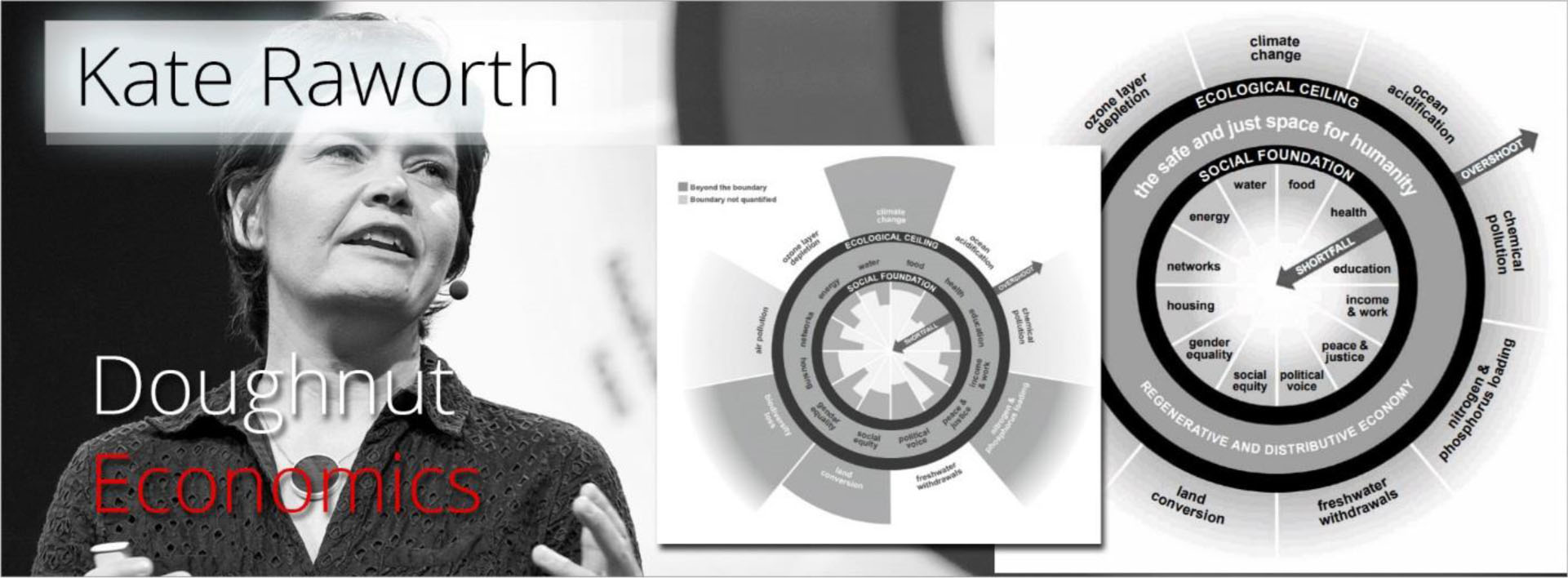
“What if we started economics not with its long-established theories but with humanity’s long-term goals, and then sought out the economic thinking that will enable us to achieve them?”
Nick Ray Ball: This is what The 64 Reasons Why are about. Š-ŔÉŚ™ increases the money supply, and then Net-Zero DCA Soft ADVANCED creates the network in a way that over 50% (and maybe 75%) of cash flow is spent ‘for the common good’ on net-zero projects.
As for long-term goals, we will soon come to Chapter 8 – Beyond 87 Quintillion Histories.
Doughnut Economics – The 8th Way
S-World and the Doughnut
This is a good model and an elegant model. It has great symmetry and is easy to understand. Consider each of the 64 Reasons Why (the 64 Special Projects) bringing problem areas outside the doughnut to within. Meticulously planned and engineered, set to a time scale that works back from 2080, creating as many possible histories (ways to get to 2080) as can be calculated, which at one billion variables per history is about 87 quintillion (87,714,630,433,327,500,000) histories (before compression).
Big numbers and quantum mechanics aside, “64 Reasons Why” presents a worthy list of causes and aspirations; and the High-Octane ŔÉŚ Financial Engineering is how we pay for it, then the Net-Zero DCA is how we make sure most of the new digital monopoly rents are spent in ways that bring problems areas into safe areas within the Doughnuts safe and just space.
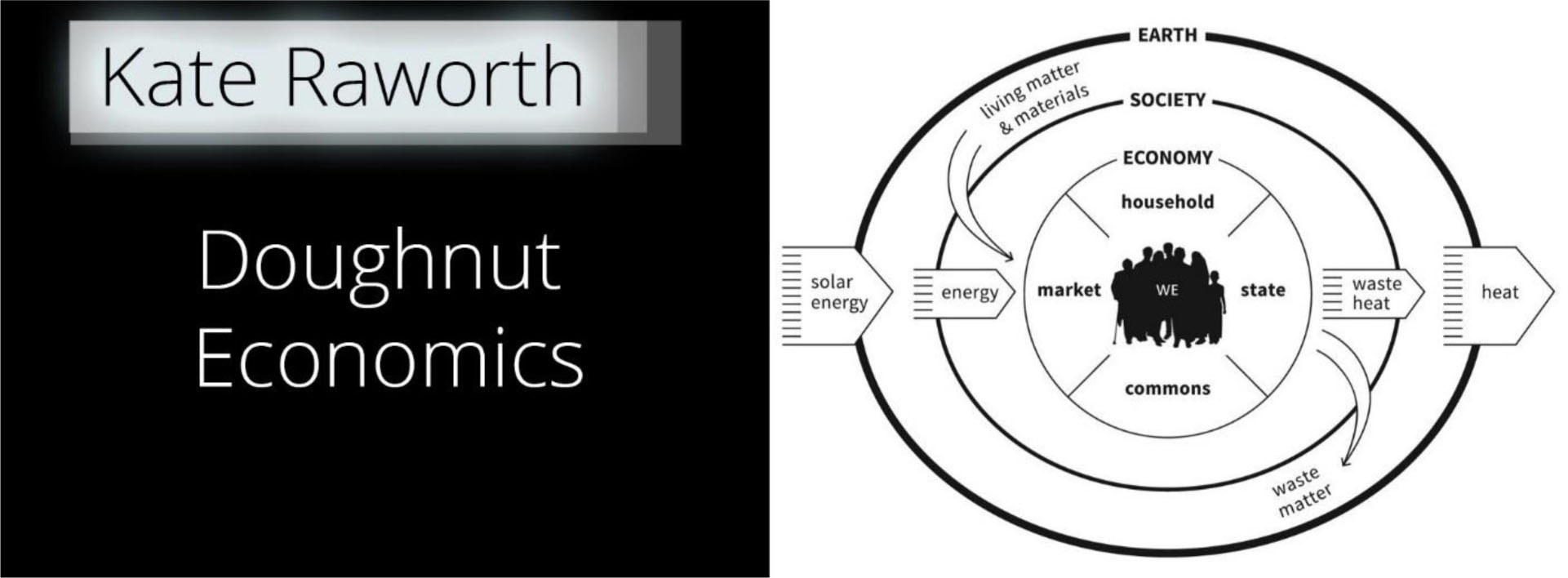
One reason why this system has not been discovered in economics before maybe because I’m not an economist, I’m a systems designer. On this, I particularly like the following quote:
“The fact that you yourself have never sat through an economics lecture may just turn out to be a distinct advantage after all: you’ve less baggage to offload, less graffiti to scrub out. Every now and then, being untutored can be an intellectual asset – and this is one of those moments.”
“ How can we Accomplish as Much Good as Possible?”

M-System 15. Angel POP
A big breakthrough in S-World City Design occurred in 2017 and can be summed up in a single sentence.
“Grand Networks in locations in extreme poverty are Special Projects.”
The idea was simply that in place of a Western powerhouse Grand Network helping Africa by funding special projects, the powerhouse – the Grand Śpin Networks would be in Africa and other poor locations, using Š-ŔÉŚ™ Financial Engineering and the many other parts to the Angelwing system to create their own Cites, which would be Net-Zero and constructed around the special projects, the Cities became the special projects, and that’s how we can do the most good.
How can we do the most good?











